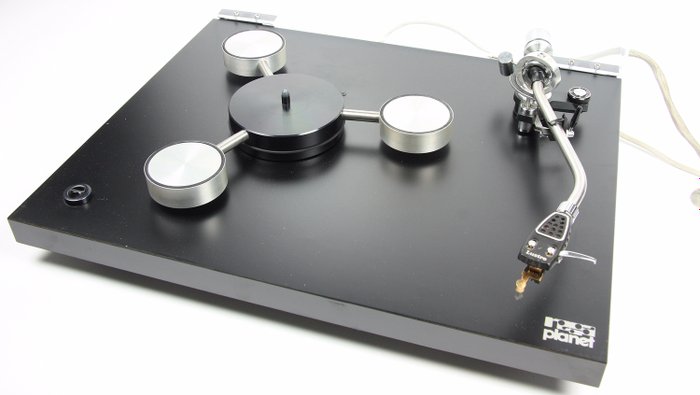When Roy Gandy’s mother asked if he wanted a record player or a television, he chose the former. But despite his best efforts, he received the latter, motivating him to pursue hi-fi in his own unique way. Four years later, he’d designed and built his own loudspeakers, begun going to shows, and started buying records to play on an old Collaro deck he’d found in a dumpster…
Roy went on to work for Ford Motor Company later in life, at which time he built and sold his own loudspeakers in his leisure time. So the tale goes, he became a part-time shopkeeper, which required him to spend an excessive amount of time maintaining turntables (which were, of course, the primary source back then). Finally, in 1973, he and his partner Tony Relph registered the name Rega (RElphGAndy) and began producing the world’s first turntable, the Planet.
It was an eye-catching record player, thanks in part to its diecast alloy platter, which made it look more like something out of 2001: A Space Odyssey than something meant for a family room. Unfortunately, it was also the turntable’s biggest design flaw, since it didn’t do a great job of supporting the record and didn’t help with speed stability. Rega quickly re-engineered the Planet as the Planar, with a thick glass platter taking over platter responsibilities – complete with a bulky felt pad on the higher-end Planar 3 to dampen the glass’s vibrations and better support the record. The glass platter on the Planar 2 was covered with a thin rubber pad.
The Planet’s plinth appears to be very ordinary by today’s standards. It’s basically a piece of MDF that’s been neatly covered and has a few grooves drilled in it for the bearing housing, motor, and tonearm. However, this is, ironically, the most radical aspect of the deck — at the time. Because, in 1973, few turntable plinths looked like this; almost all were suspended or spring-loaded to begin with, following the Garrard SP25 or Thorens TD160 paradigms. It seemed futuristic to have a thin ‘fillet’ of fiberboard sitting on three rubber feet. Of course, it couldn’t tolerate vibrations very well, which is a flaw shared by all Rega turntables to this day, therefore the Planet (and its offspring) should be placed well away from loudspeakers, preferably on a wall shelf. The vibration isolation issue, however, becomes significantly less of a concern when properly sited and levelled.
Regas used a multi-pole AC synchronous motor to drive a small plastic inner subplatter through a thin rubber belt, similar to many other belt drives of the time. The manufacturer claimed a wow and flutter rate of 0.08 percent, which is a respectable but unremarkable figure. Rega’s 24v high performance motor upgrade kit will suit the Planet, allowing you to use the special TT PSU, which should enhance speed stability significantly. Although it is not cheap, completists may consider it to be fair value.
The deck was furnished with a high-quality smoked Perspex dust cover that was significantly superior to that of most price competitors, however, like with all turntables, the deck sounded much better with it removed entirely. The Planet can provide a decent sound when properly seated on the platter and aided by a record clamp (Michell’s clamp is a suitable choice here because it’s not too hefty and nevertheless fastens down the disc). It will be even better if you provide it with a suitable turntable mat. The GA Audio Sounddisc, a high-quality glass turntable mat, was the thing to have back in the day. For less than £90, a SoundDeadSteel CD provides significantly superior effects.
The bearing is fairly normal Rega fare, and it rumbles at a respectable 65dB. Removing the old bearing oil with a cotton bud and isopropyl alcohol and re-lubricating with contemporary synthetic oil such as Redline 5W30 can greatly benefit any secondhand Planet (or indeed Planar). The inner section of the platter is driven directly by a rubber belt from the metal motor pulley, which is still available from Rega today, so any old one is well worth replacing.
The deck was available with either a SME-cutout and no arm, or with an Acos-derived S-shaped aluminium tubed tonearm (of 237mm effective length, overhang 15mm) of Japanese manufacture. SME’s then-ubiquitous 3009S2 was partnered by a large number of Planets. Improved with good results, despite the fact that the given arm was also quite good. The installation of an ADC magnesium headshell, which was marginally lighter than the factory aluminium designs but significantly stronger, reduced resonances and allowed owners to clamp their cartridges tighter, was a popular upgrade for both the SME and the Acos arms.
The Planet is a good enough item to listen to, even with all the aforementioned alterations – smooth, warm, and sweet, albeit a little soft around the edges. You get a pretty spacious sound that’s comfortable on the ears at all times; it’s a reminder of how fantastic good turntables of that era were in this regard. Even yet, it lags much behind a current Rega RP3 or even a Planar 3 from two decades ago.
The Planet is a good used purchase; it’s easy to maintain and run, with most parts being serviceable or replaceable, and parts being inexpensive. They’re expensive, with examples ranging from £100 to £200 depending on condition — this isn’t much different from later Planar 3s, but keep in mind that the Planet is a more rare beast. There aren’t many unidentified playing things like this!






